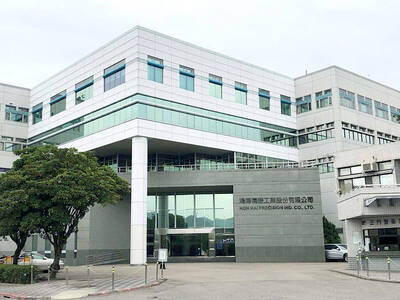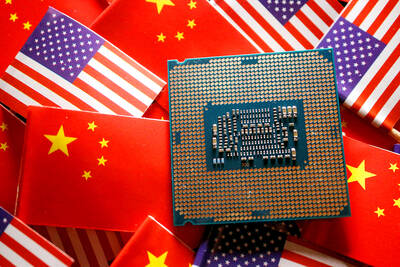Taiwan’s annual energy reserve capacity margin could consistently drop to below 10 percent by 2018, as the planned power generation capacity might not meet rising domestic energy demands, sharply increasing the chance of power shortages, state-run Taiwan Power Co (Taipower 台電) said yesterday.
The prediction of the potential shortage has been moved forward two years partly due to a delayed replacement of the Tongxiao natural gas-fired power plant (通霄電廠) in Miaoli County, the company said.
Taipower said it initially encountered difficulties in obtaining construction licenses.
“The energy reserve capacity margin could plunge to 4.8 percent by 2019 following the retirement of the second reactor of the Jinshan Nuclear Power Plant in New Taipei City’s Shihmen District (石門),” Taipower spokesman Roger Lee (李鴻洲) said at a press conference.
The annual power reserve capacity margin refers to a utility’s capacity to generate more energy than the total power system normally requires.
Taipower said it is better to maintain the reserve margin of 15 percent as insurance against breakdowns or a sudden surge in electricity demand.
Every year, Taipower releases a forecast of annual power reserve capacity for the next few years based on the nation’s electricity demand and economic growth.
Lee said this year’s reserve capacity margin is 10.4 percent, down 4.3 percentage points from last year’s 14.7 percent, due to the retirement of two power generation units of a coal-fired power plant in Linkou District (林口), New Taipei City.
Based on past records, the nation could face power rationing measures if the energy reserve margin drops below 7.4 percent, Lee said.
“To reduce the chance of power shortages, the nation has to conserve energy and the government must speed up the installation of renewable energy sources, such as solar and wind power generation,” Lee said.
In a separate press conference, the Bureau of Energy said it plans to increase its power contribution to renewable energy sources from this year’s 11.6 percent to 30.7 percent by 2030.
In a bid to accelerate the diversification of Taiwan’s energy sources and deal with the increasing risk of power shortages, the bureau is to boost the target for total installed capacity of renewal energy sources to 17,250 megawatts (MW) by 2030 from the previous target of 13,750 MW, bureau Director-General Lin Chuan-neng (林全能) said.
“We plan to relax the bidding regulations for solar power and wind power installations to achieve our target,” Lin said.

Shares in Taiwan closed at a new high yesterday, the first trading day of the new year, as contract chipmaker Taiwan Semiconductor Manufacturing Co (TSMC, 台積電) continued to break records amid an artificial intelligence (AI) boom, dealers said. The TAIEX closed up 386.21 points, or 1.33 percent, at 29,349.81, with turnover totaling NT$648.844 billion (US$20.65 billion). “Judging from a stronger Taiwan dollar against the US dollar, I think foreign institutional investors returned from the holidays and brought funds into the local market,” Concord Securities Co (康和證券) analyst Kerry Huang (黃志祺) said. “Foreign investors just rebuilt their positions with TSMC as their top target,

REVENUE PERFORMANCE: Cloud and network products, and electronic components saw strong increases, while smart consumer electronics and computing products fell Hon Hai Precision Industry Co (鴻海精密) yesterday posted 26.51 percent quarterly growth in revenue for last quarter to NT$2.6 trillion (US$82.44 billion), the strongest on record for the period and above expectations, but the company forecast a slight revenue dip this quarter due to seasonal factors. On an annual basis, revenue last quarter grew 22.07 percent, the company said. Analysts on average estimated about NT$2.4 trillion increase. Hon Hai, which assembles servers for Nvidia Corp and iPhones for Apple Inc, is expanding its capacity in the US, adding artificial intelligence (AI) server production in Wisconsin and Texas, where it operates established campuses. This

US President Donald Trump on Friday blocked US photonics firm HieFo Corp’s US$3 million acquisition of assets in New Jersey-based aerospace and defense specialist Emcore Corp, citing national security and China-related concerns. In an order released by the White House, Trump said HieFo was “controlled by a citizen of the People’s Republic of China” and that its 2024 acquisition of Emcore’s businesses led the US president to believe that it might “take action that threatens to impair the national security of the United States.” The order did not name the person or detail Trump’s concerns. “The Transaction is hereby prohibited,”

Garment maker Makalot Industrial Co (聚陽) yesterday reported lower-than-expected fourth-quarter revenue of NT$7.93 billion (US$251.44 million), down 9.48 percent from NT$8.76 billion a year earlier. On a quarterly basis, revenue fell 10.83 percent from NT$8.89 billion, company data showed. The figure was also lower than market expectations of NT$8.05 billion, according to data compiled by Yuanta Securities Investment and Consulting Co (元大投顧), which had projected NT$8.22 billion. Makalot’s revenue this quarter would likely increase by a mid-teens percentage as the industry is entering its high season, Yuanta said. Overall, Makalot’s revenue last year totaled NT$34.43 billion, down 3.08 percent from its record NT$35.52